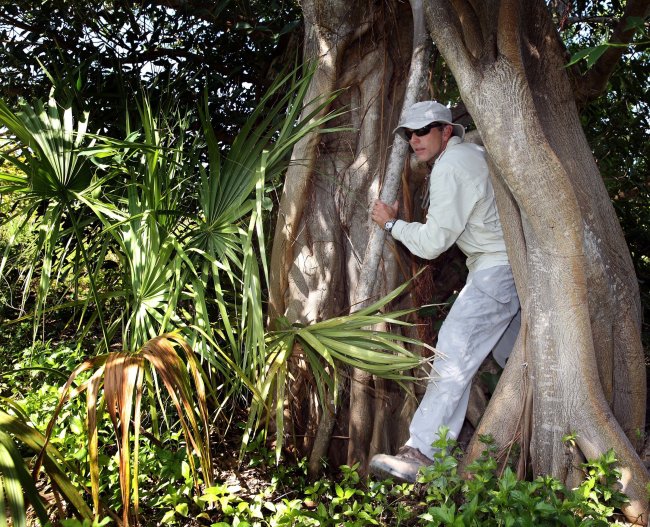Miami’s Virginia Key transforms from desolate hammock to tropical wilderness
By Korea HeraldPublished : June 27, 2014 - 20:36
MIAMI ― Just seven years ago, the 17-acre hammock in Historic Virginia Key Beach Park was as desolate as a moonscape, but now it brims with native plants and wildlife.
Volunteer Gary Hunt, armed with a Home Depot fanny pack and a floppy tan hat, walks the overgrown path, pointing out hundreds of new trees and recalling the owls and warblers he has spotted in the park.
“This shows you very profoundly what volunteer effort can do,” Hunt said.
Volunteers like Hunt have helped transform Virginia Key into a destination for wildlife and locals alike, during many hot, mosquito-ridden weekends of planting trees and maintaining park grounds.
“We’re trying to position Virginia Key as the City of Miami Central Park,” said Guy Forchion, the executive director of Virginia Key Beach Park Trust.
Just last month, Tourism Cares, a Massachusetts-based volunteer group of travel professionals, brought 325 people to Virginia Key. They planted nearly 800 trees in the hammock and 11,000 sea oats at the North Point, an area on the tip of the island. The group also cleaned debris from Miami Marine Stadium, a once-popular destination on Virginia Key for concerts and power boating.
Volunteer Gary Hunt, armed with a Home Depot fanny pack and a floppy tan hat, walks the overgrown path, pointing out hundreds of new trees and recalling the owls and warblers he has spotted in the park.
“This shows you very profoundly what volunteer effort can do,” Hunt said.
Volunteers like Hunt have helped transform Virginia Key into a destination for wildlife and locals alike, during many hot, mosquito-ridden weekends of planting trees and maintaining park grounds.
“We’re trying to position Virginia Key as the City of Miami Central Park,” said Guy Forchion, the executive director of Virginia Key Beach Park Trust.
Just last month, Tourism Cares, a Massachusetts-based volunteer group of travel professionals, brought 325 people to Virginia Key. They planted nearly 800 trees in the hammock and 11,000 sea oats at the North Point, an area on the tip of the island. The group also cleaned debris from Miami Marine Stadium, a once-popular destination on Virginia Key for concerts and power boating.

Tourism Cares’ planting marked a milestone in the ongoing restoration project: the end of major replanting on the neglected property.
“I call this the icing on the cake. This is the cherry on top,” Forchion said.
But for volunteers like Hunt, there is no time to rest. They will continue to clear the paths, maintain trees and eradicate pesky invasive species.
Despite the humidity and the bugs, volunteers from groups like Tourism Cares and TREEmendous Miami, a group dedicated to planting trees across the city, continue to frequent the muggy hammock because they feel strongly about the environmental impact the plants will have.
During hurricanes and severe weather, these plants help protect the mainland from high wind, said Gloria Antia, the executive director for Citizens for a Better South Florida, another group working to restore the island. She added that the plants will make the beach itself more storm resistant.
Virginia Key is also an important pit stop for migratory birds. Though condominiums on the coast of Florida have snagged much of the prime real estate for birds, Virginia Key remains an important feeding ground for birds, Hunt said. Birds that frequent the island include vireos, warblers and falcons.
Though the hammock on Historic Virginia Key Beach has been the focus of restoration efforts, other areas of the island are also receiving a facelift. Heavy construction equipment is at work on the North Point clearing the way for new sea oats and providing sea turtles with a place to lay their eggs. Several sea turtle nests, marked by signs, have cropped up since the restoration started.
On the shores of Biscayne Bay, the Miami Marine Stadium is likely cleaner now than it has been since it closed in 1992, Forchion said. Carolyn Cauceglia, who is on the board of directors of Tourism Cares, said she remembers attending concerts there years ago, when stars like the Beach Boys drew boaters to the bay as the sounds of surf and sand wafted over the water.
The stadium has been closed since Hurricane Andrew, but if restoration efforts are successful, it may one day be functional again. While Forchion wants to turn Virginia Key into Miami’s Central Park, Cauceglia said she hopes the Miami Marine Stadium will become the city’s Sydney Opera House.
“To me it’s a hidden jewel on Biscayne Bay,” Cauceglia said.
Besides going back to its roots environmentally, the island is marking its historical past. Beginning in 1945, Historic Virginia Key Beach Park was designated as the only beach for black residents in Miami. It was placed on the National Register of Historic Places in 2002. While all of the historic buildings have been restored, Forchion said he is working to build a center that tells the history of the island.
As the restoration continues to grow, both in the scope of the project and in newly planted trees that will someday shade the hammock, Forchion marveled at the transformation.
“It’s a living, breathing place,” he said.
By Monica Disare
(The Miami Herald)
(MCT Information Services)
-
Articles by Korea Herald



![[AtoZ into Korean mind] Humor in Korea: Navigating the line between what's funny and not](http://res.heraldm.com/phpwas/restmb_idxmake.php?idx=644&simg=/content/image/2024/04/22/20240422050642_0.jpg&u=)
![[Exclusive] Korean military set to ban iPhones over 'security' concerns](http://res.heraldm.com/phpwas/restmb_idxmake.php?idx=644&simg=/content/image/2024/04/23/20240423050599_0.jpg&u=20240423183955)



![[Graphic News] 77% of young Koreans still financially dependent](http://res.heraldm.com/phpwas/restmb_idxmake.php?idx=644&simg=/content/image/2024/04/22/20240422050762_0.gif&u=)
![[Herald Interview] Why Toss invited hackers to penetrate its system](http://res.heraldm.com/phpwas/restmb_idxmake.php?idx=644&simg=/content/image/2024/04/22/20240422050569_0.jpg&u=20240422150649)






![[Exclusive] Korean military to ban iPhones over security issues](http://res.heraldm.com/phpwas/restmb_idxmake.php?idx=652&simg=/content/image/2024/04/23/20240423050599_0.jpg&u=20240423183955)



![[Today’s K-pop] Ateez confirms US tour details](http://res.heraldm.com/phpwas/restmb_idxmake.php?idx=642&simg=/content/image/2024/04/23/20240423050700_0.jpg&u=)